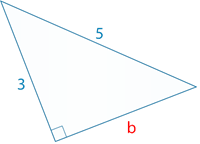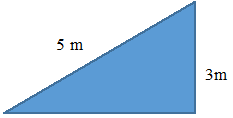4.34: Solving Equations Using the Pythagorean Theorem
- Page ID
- 4969
\( \newcommand{\vecs}[1]{\overset { \scriptstyle \rightharpoonup} {\mathbf{#1}} } \)
\( \newcommand{\vecd}[1]{\overset{-\!-\!\rightharpoonup}{\vphantom{a}\smash {#1}}} \)
\( \newcommand{\dsum}{\displaystyle\sum\limits} \)
\( \newcommand{\dint}{\displaystyle\int\limits} \)
\( \newcommand{\dlim}{\displaystyle\lim\limits} \)
\( \newcommand{\id}{\mathrm{id}}\) \( \newcommand{\Span}{\mathrm{span}}\)
( \newcommand{\kernel}{\mathrm{null}\,}\) \( \newcommand{\range}{\mathrm{range}\,}\)
\( \newcommand{\RealPart}{\mathrm{Re}}\) \( \newcommand{\ImaginaryPart}{\mathrm{Im}}\)
\( \newcommand{\Argument}{\mathrm{Arg}}\) \( \newcommand{\norm}[1]{\| #1 \|}\)
\( \newcommand{\inner}[2]{\langle #1, #2 \rangle}\)
\( \newcommand{\Span}{\mathrm{span}}\)
\( \newcommand{\id}{\mathrm{id}}\)
\( \newcommand{\Span}{\mathrm{span}}\)
\( \newcommand{\kernel}{\mathrm{null}\,}\)
\( \newcommand{\range}{\mathrm{range}\,}\)
\( \newcommand{\RealPart}{\mathrm{Re}}\)
\( \newcommand{\ImaginaryPart}{\mathrm{Im}}\)
\( \newcommand{\Argument}{\mathrm{Arg}}\)
\( \newcommand{\norm}[1]{\| #1 \|}\)
\( \newcommand{\inner}[2]{\langle #1, #2 \rangle}\)
\( \newcommand{\Span}{\mathrm{span}}\) \( \newcommand{\AA}{\unicode[.8,0]{x212B}}\)
\( \newcommand{\vectorA}[1]{\vec{#1}} % arrow\)
\( \newcommand{\vectorAt}[1]{\vec{\text{#1}}} % arrow\)
\( \newcommand{\vectorB}[1]{\overset { \scriptstyle \rightharpoonup} {\mathbf{#1}} } \)
\( \newcommand{\vectorC}[1]{\textbf{#1}} \)
\( \newcommand{\vectorD}[1]{\overrightarrow{#1}} \)
\( \newcommand{\vectorDt}[1]{\overrightarrow{\text{#1}}} \)
\( \newcommand{\vectE}[1]{\overset{-\!-\!\rightharpoonup}{\vphantom{a}\smash{\mathbf {#1}}}} \)
\( \newcommand{\vecs}[1]{\overset { \scriptstyle \rightharpoonup} {\mathbf{#1}} } \)
\( \newcommand{\vecd}[1]{\overset{-\!-\!\rightharpoonup}{\vphantom{a}\smash {#1}}} \)
\(\newcommand{\avec}{\mathbf a}\) \(\newcommand{\bvec}{\mathbf b}\) \(\newcommand{\cvec}{\mathbf c}\) \(\newcommand{\dvec}{\mathbf d}\) \(\newcommand{\dtil}{\widetilde{\mathbf d}}\) \(\newcommand{\evec}{\mathbf e}\) \(\newcommand{\fvec}{\mathbf f}\) \(\newcommand{\nvec}{\mathbf n}\) \(\newcommand{\pvec}{\mathbf p}\) \(\newcommand{\qvec}{\mathbf q}\) \(\newcommand{\svec}{\mathbf s}\) \(\newcommand{\tvec}{\mathbf t}\) \(\newcommand{\uvec}{\mathbf u}\) \(\newcommand{\vvec}{\mathbf v}\) \(\newcommand{\wvec}{\mathbf w}\) \(\newcommand{\xvec}{\mathbf x}\) \(\newcommand{\yvec}{\mathbf y}\) \(\newcommand{\zvec}{\mathbf z}\) \(\newcommand{\rvec}{\mathbf r}\) \(\newcommand{\mvec}{\mathbf m}\) \(\newcommand{\zerovec}{\mathbf 0}\) \(\newcommand{\onevec}{\mathbf 1}\) \(\newcommand{\real}{\mathbb R}\) \(\newcommand{\twovec}[2]{\left[\begin{array}{r}#1 \\ #2 \end{array}\right]}\) \(\newcommand{\ctwovec}[2]{\left[\begin{array}{c}#1 \\ #2 \end{array}\right]}\) \(\newcommand{\threevec}[3]{\left[\begin{array}{r}#1 \\ #2 \\ #3 \end{array}\right]}\) \(\newcommand{\cthreevec}[3]{\left[\begin{array}{c}#1 \\ #2 \\ #3 \end{array}\right]}\) \(\newcommand{\fourvec}[4]{\left[\begin{array}{r}#1 \\ #2 \\ #3 \\ #4 \end{array}\right]}\) \(\newcommand{\cfourvec}[4]{\left[\begin{array}{c}#1 \\ #2 \\ #3 \\ #4 \end{array}\right]}\) \(\newcommand{\fivevec}[5]{\left[\begin{array}{r}#1 \\ #2 \\ #3 \\ #4 \\ #5 \\ \end{array}\right]}\) \(\newcommand{\cfivevec}[5]{\left[\begin{array}{c}#1 \\ #2 \\ #3 \\ #4 \\ #5 \\ \end{array}\right]}\) \(\newcommand{\mattwo}[4]{\left[\begin{array}{rr}#1 \amp #2 \\ #3 \amp #4 \\ \end{array}\right]}\) \(\newcommand{\laspan}[1]{\text{Span}\{#1\}}\) \(\newcommand{\bcal}{\cal B}\) \(\newcommand{\ccal}{\cal C}\) \(\newcommand{\scal}{\cal S}\) \(\newcommand{\wcal}{\cal W}\) \(\newcommand{\ecal}{\cal E}\) \(\newcommand{\coords}[2]{\left\{#1\right\}_{#2}}\) \(\newcommand{\gray}[1]{\color{gray}{#1}}\) \(\newcommand{\lgray}[1]{\color{lightgray}{#1}}\) \(\newcommand{\rank}{\operatorname{rank}}\) \(\newcommand{\row}{\text{Row}}\) \(\newcommand{\col}{\text{Col}}\) \(\renewcommand{\row}{\text{Row}}\) \(\newcommand{\nul}{\text{Nul}}\) \(\newcommand{\var}{\text{Var}}\) \(\newcommand{\corr}{\text{corr}}\) \(\newcommand{\len}[1]{\left|#1\right|}\) \(\newcommand{\bbar}{\overline{\bvec}}\) \(\newcommand{\bhat}{\widehat{\bvec}}\) \(\newcommand{\bperp}{\bvec^\perp}\) \(\newcommand{\xhat}{\widehat{\xvec}}\) \(\newcommand{\vhat}{\widehat{\vvec}}\) \(\newcommand{\uhat}{\widehat{\uvec}}\) \(\newcommand{\what}{\widehat{\wvec}}\) \(\newcommand{\Sighat}{\widehat{\Sigma}}\) \(\newcommand{\lt}{<}\) \(\newcommand{\gt}{>}\) \(\newcommand{\amp}{&}\) \(\definecolor{fillinmathshade}{gray}{0.9}\)Use a-squared + b-squared = c-squared to find missing side lengths of right triangles.

Gary wants to build a skateboard ramp, but it can’t be too steep. If he has a platform 3 m high and a board 5 m long, how far out should the board extend from the platform?
In this concept, you will learn how to solve equations using the Pythagorean Theorem.
The Pythagorean Theorem states that the sum of the squares of the two legs of a right triangle is equal to the square of the hypotenuse. In a math sentence, where a and b are the legs and c is the hypotenuse, it looks like this:
\(c^2=a^2+b^2\)
Mathematically, you can use this equation to solve for any of the variables, not just the hypotenuse.
For example, the right triangle below has one leg equal to 3 and a hypotenuse of 5.
Solve for the other leg.

First, you can label either leg \(a\) or \(b\). Remember that the legs are those sides adjacent to the right angle.
Next, fill into the Pythagorean Theorem the values that you know.
\(\begin{align*} c^2 &= a^2+b^2 \\ 5^2 &= 3^2+b^2 \end{align*}\)
Then, perform the calculations you are able to.
\(25=9+b^2\)
Remember that your goal is to isolate the unknown variable on one side of the equation. In this case it is b and it is attached to a square and a+9. Perform the necessary operations to isolate b.
\(\begin{align*} 25−9 &= 9+b^2−9 \\ 16 &= b^2 \\ 4 &= b \end{align*}\)
The answer is 4.
Example \(\PageIndex{1}\)
Earlier, you were given a problem about Gary and his skate board ramp.
Solution
One side, the base, was 4 m and the board, the hypotenuse, was 5 m. How high would the ramp be?

First, substitute.
\(5^2=3^2+b^2\)
Next, perform the calculations.
\(\begin{align*} 25 &= 9+b^2 \\ 25−9 &= 9+b^2−9 \end{align*}\)
Then, determine the square roots.
\(\begin{align*} 16 &= b^2 \\ 4 &= b \end{align*}\)
The answer is 4 m. Gary’s board should extend 4 m from the base of the platform.
Example \(\PageIndex{2}\)
Solve for b to the nearest tenth.

Solution
First, take the given lengths and substitute them into the formula.
\(\begin{align*} 4^2+b^2 &= 122 \\ 16+b^2 &= 144 \end{align*}\)
Next, subtract 16 from both sides of the equation.
\(\begin{align*} 16−16+b^2 &= 144−16 \\ b^2 &= 128 \end{align*}\)
Then take the square root of both sides of the equation.
\(b = 11.3137085 \ldots \)
Round to the tenths place
\(b\neq 11.3\)
The answer is 11.3
Example \(\PageIndex{3}\)
A right triangle includes the dimensions of \(a\), \(b=6\) and \(c=13\). Solve for a\).
Solution
First, substitute.
\(\begin{align*} c^2 &= a^2+b^2 \\ 13^2 &= a^2+6^2 \end{align*}\)
Next, perform the calculations you are able to.
\(\begin{align*} 169 &= a^2+36 \\ 169−36 &= a^2+36−36 \\ 133 &= a^2 \\ 11.532582594 \ldots &= a \\ 11.5 &\approx a \end{align*}\)
The answer is \(a=11.5\).
Example \(\PageIndex{4}\)
A right triangle with \(a=8\),\(b\), and \(c=12\)
Solution
First, substitute.
\(\begin{align*} c^2 &= a^2+b^2 \\ 12^2 &= 8^2+b^2 \end{align*}\)
Next, perform the calculations.
\(\begin{align*} 144 &= 64+b^2 \\ 144−64 &= 64+b^2−64 \end{align*}\)
Then, determine the square roots.
\(\begin{align*} 80 &= b^2 \\ 8.9 &\neq b \end{align*}\)
The answer is 8.9
Example \(\PageIndex{5}\)
A right triangle with \(a=6\), \(b\), and \(c=10\)
Solution
First, substitute.
\(\begin{align*} c^2 &= a^2+b^2 \\ 10^2 &= 6^2+b^2 \end{align*}\)
Next, perform the calculations.
\(\begin{align*} 100 &= 36+b^2 \\ 100−36 &= 36+b^2−36 \end{align*}\)
Then, determine the square roots.
\(\begin{align*} 64 &= b^2 \\ 8 &= b \end{align*} \)
The answer is 8.
Review
Use the Pythagorean Theorem to find the length of each missing leg. You may round to the nearest tenth when necessary.
- \(a=6, \:b=?, \:c=12 \)
- \(a=9, \:b=?, \:c=15 \)
- \(a=4, \:b=?, \:c=5 \)
- \(a=9, \:b=?, \:c=18 \)
- \(a=15, \:b=?, \:c=25 \)
- \(a=?, \:b=10, \:c=12 \)
- \(a=?, \:b=11,\: c=14 \)
- \(a=?,\: b=13,\: c=15 \)
Write an equation using the Pythagorean Theorem and solve each problem.
Joanna laid a plank of wood down to make a ramp so that she could roll a wheelbarrow over a low wall in her garden. The wall is 1.5 meters tall, and the plank of wood touches the ground 2 meters from the wall. How long is the wooden plank?
- Write the equation.
- Solve for the answer.
Chris rode his bike 4 miles west and then 3 miles south. What is the shortest distance he can ride back to the point where he started?
- Write the equation.
- Solve the problem.
Naomi is cutting triangular patches to make a quilt. Each has a diagonal side of 14.5 inches and a short side of 5.5 inches. What is the length of the third side of each triangular patch?
- Write the equation.
- Solve the problem.
Resources
Vocabulary
| Term | Definition |
|---|---|
| Hypotenuse | The hypotenuse of a right triangle is the longest side of the right triangle. It is across from the right angle. |
| Legs of a Right Triangle | The legs of a right triangle are the two shorter sides of the right triangle. Legs are adjacent to the right angle. |
| Pythagorean Theorem | The Pythagorean Theorem is a mathematical relationship between the sides of a right triangle, given by \(a^2+b^2=c^2\), where a and b are legs of the triangle and c is the hypotenuse of the triangle. |
Additional Resources
Interactive Element
Video: The Pythagorean Theorem with Variables: A Sample Application
Practice: Solving Equations Using the Pythagorean Theorem
Real World: Cryptic Notes

